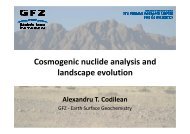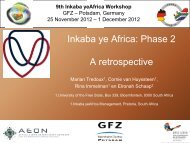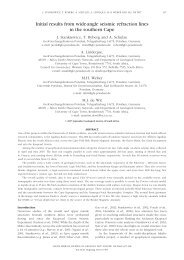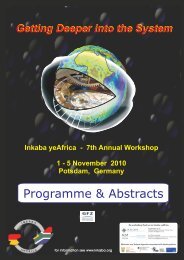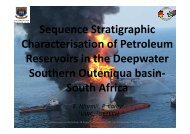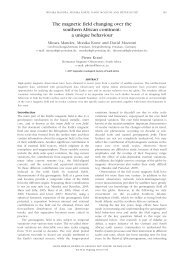South Africa - Inkaba.org
South Africa - Inkaba.org
South Africa - Inkaba.org
Create successful ePaper yourself
Turn your PDF publications into a flip-book with our unique Google optimized e-Paper software.
Structural and geophysical transect across an archean suture<br />
zone, Barberton Greenstone Belt<br />
Scott MacLennan 1 , Ute Weckmann 2 , Oliver Ritter 3 Maarten De Wit 4<br />
1. AEON, UCT, GFZ, <strong>South</strong> <strong>Africa</strong>, scottangusmac@gmail.com<br />
2. GFZ, Germany, uweck@gfz-potsdam.de<br />
3. GFZ, Germany, Oliver.Ritter@gfz-potsdam.de<br />
4. AEON, UCT, <strong>South</strong> <strong>Africa</strong>, Maarten.dewit@uct.ac.za<br />
ABSTRACT<br />
In 2009 a magnetotelluric field campaign was carried out in the southern part of Barberton Greenstone Belt. The<br />
profile was positioned at right angles to the NE-SW structural grain of the Greenstone Belt. While initial results<br />
showed that there are vertical zones of high conductivity that correspond to major Archean shear zones, the data<br />
quality was poor. A second field campaign August 2010 was conducted to collect more robust data.<br />
Previously the southern extent of the Moodies- Inyoka fault system was investigated using structural techniques,<br />
with a particular focus on the Stolzberg layered ultra mafic complex, which lies directly adjacent to the Moodies<br />
fault. This serpentinised ultramafic complex has a complicated history and the less resistant serpentinite units have<br />
many different generations of deformation. The serpentinites are now composed of many separate blocks, which<br />
are separated by fault surfaces. These surfaces show a multitude of slickenfibres of different orientations. A series<br />
of abandoned Asbestos mines within these serpentinites serves as an ideal location to study this deformation in<br />
detail, owing to the excellent exposure. This analysis revealed that the deformation in this ultramafic unit was not<br />
uniform, where the south western extent of the complex showed more strike slip motion, while in the north east<br />
low to high angle reverse faults dominate. This change happens on the km scale. The data are not well constrained<br />
though, showing low precision. This is attributed to the ease in which these serpentinites are deformed, creating<br />
complex structural patterns.<br />
Samples of major lithologies and rocks associated with shear zones from within the greenstone belt were collected<br />
to test their electrical conductivity. This data will be used to constrain some of the modeling results from the<br />
magnetotelluric survey and attempt to determine which material is responsible for the high conductivities observed<br />
within these Archean suture zones.<br />
KEYWORDS: archean, tectonics, magnetotellurics, serpentinites<br />
46



